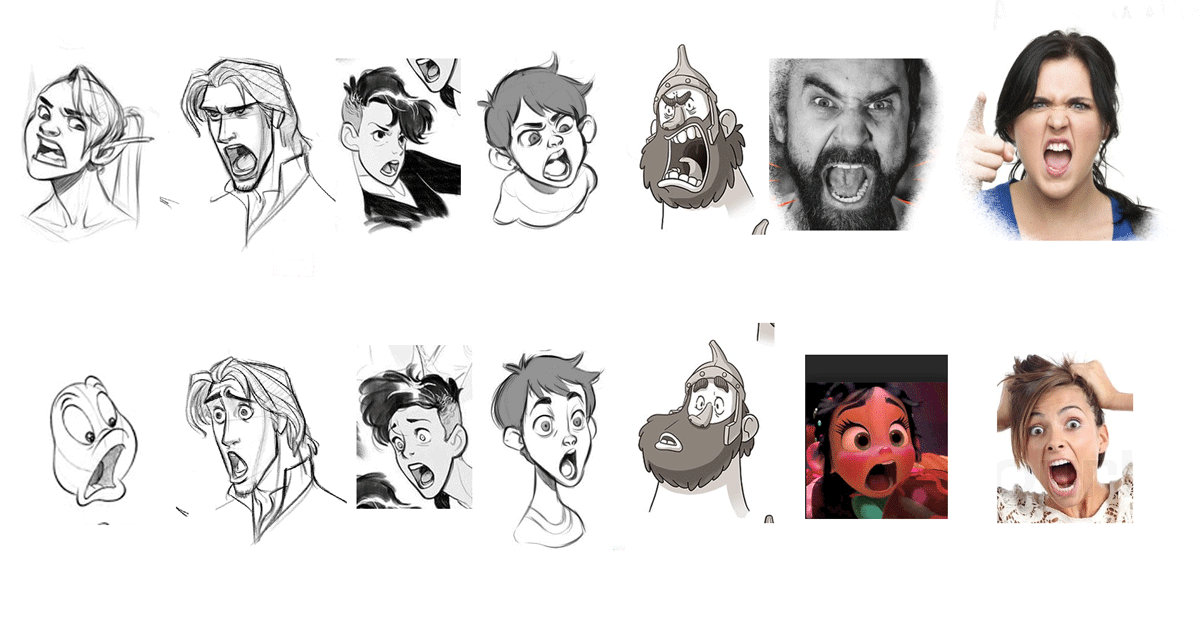Facial Expressions
-
@jon-anderson True, and I have done so as well, but I'd love the theory behind what makes a surprised face vs. a scared face etc. It's the theory I am after really. I suppose I should've clarified that. Thank you!
-
I can vouch for the Mark Simon and Scott McCloud books. They're awesome. I think one of Mark Simon's books is purchasable as a PDF.
I don't use much of reference for expressions anymore, though.
Something to keep in mind: think of the face you're workin' with as super-flexi rubber. Sure, the teeth and eyes aren't going anywhere but the skin warps, stretches, bunches and can generally go anywhere you want. I've found that the my portraits that look most 'right' are the ones I've exaggerated the most. Try going over the top.
Something weird to do: I find myself actively unconsciously making the expression I'm drawing. Not in the mirror or anything, but while I'm actively drawing. Really grimacing, smiling, laughing, squinting etc. seems to help with working with expressions. It makes for some really strange looks from people while I'm doing conventions, though...
Good luck! Faces are hard...
Also, there is an SVS course called (I think) stylizing portraits which has some great tips on capturing likenesses.
-
It looks like the upcoming @davidhohn course is going to go into facial expression. It won't be in the subscription until the fall though.
-
Hi Bob, I don't know about courses, but one thing that helps me is looking at character design expression concepts and then cross referencing them with eachother as well as with photographs of real people. With them all compared to each other, you really see the commonalities that represent a certain expression and then it's easier to apply them to your own character.
For example, I've pulled a bunch of different "angry yelling" expressions and they all have very similar qualities.
- Furrowed brows that move closer to the eyes.
- Showing more white in the eye
- Nose scrunched up at bridge between eyes
- Square or trapizoid shaped mouth
- showing upper and lower teeth with a mostly pulled back tongue
For surprised/scared yelling
1.raised eyebrows, sometimes furrowed
2. trapezoid mouth
3. lot's of white around the cornea
Anyway, that's what has helped me. If you analyze like this, it will start to become internalized and you won't need to look at reference as much in the future.
-
@bob-crum I'm interested in learning about the qualities of different expressions as well, but I haven't looked into it much yet.
You might want to look up Paul Ekman, a psychologist "who is a pioneer in the study of emotions and their relation to facial expressions." (Wikipedia) He's well known due to the TV show "Lie to Me". He's written several books, including "Unmasking the Face: A Guide to Recognizing Emotions from Facial Clues" (with Wallace V. Friesen)
Amazon: https://smile.amazon.com/Unmasking-Face-Recognizing-Emotions-Expressions/dp/1883536367/ref=tmm_pap_swatch_0?_encoding=UTF8&qid=1530585983&sr=8-1From the reviews I've read, it's more of a reference book or textbook, rather than reading for entertainment, but it describes the facial expressions of basic emotions including the muscles used for different expressions.
Paul Ekman and Wallace Friesen's work has a lot to do with people trying to hide their emotions (whether consciously or subconsciously), but most people can't stop a tiny flash of the emotion on their face or in a gesture of the body. And the facial expressions look the same during these miro-expressions as expressions that are displayed openly. They also found that basic expressions are universal around the world.
Paul Ekman also has training programs to learn how to read microexpressions.
Paul Ekman Group: https://www.paulekman.com/ -
@tessaw you're awesome! Very helpful



-
You should look at Arron Blaise's free you tube explanation of how Disney animators explained facial expressions to him when he first started working there. He slso has some other character stuff that is great for the subject
-
The old Preston B;air art books were great for expressions. You can purchase them on amazon or do a google search. and many of the pages come up.
-
Someone mention the book Making Comics already although that's one section of large book so may not be worth buying it for that. @TESSAW's example of collecting reference is a good idea. Also the Etherington Brothers do a weekly free series called "How to think when you draw" one of which was on angry expressions which might help.
-
The Artist's Complete Guide to Facial Expression by Gary Faigin.
This is a great book. The link is to a later edition than the one I have, but I think it's the same contents. Looks like you could get a used copy pretty cheap.